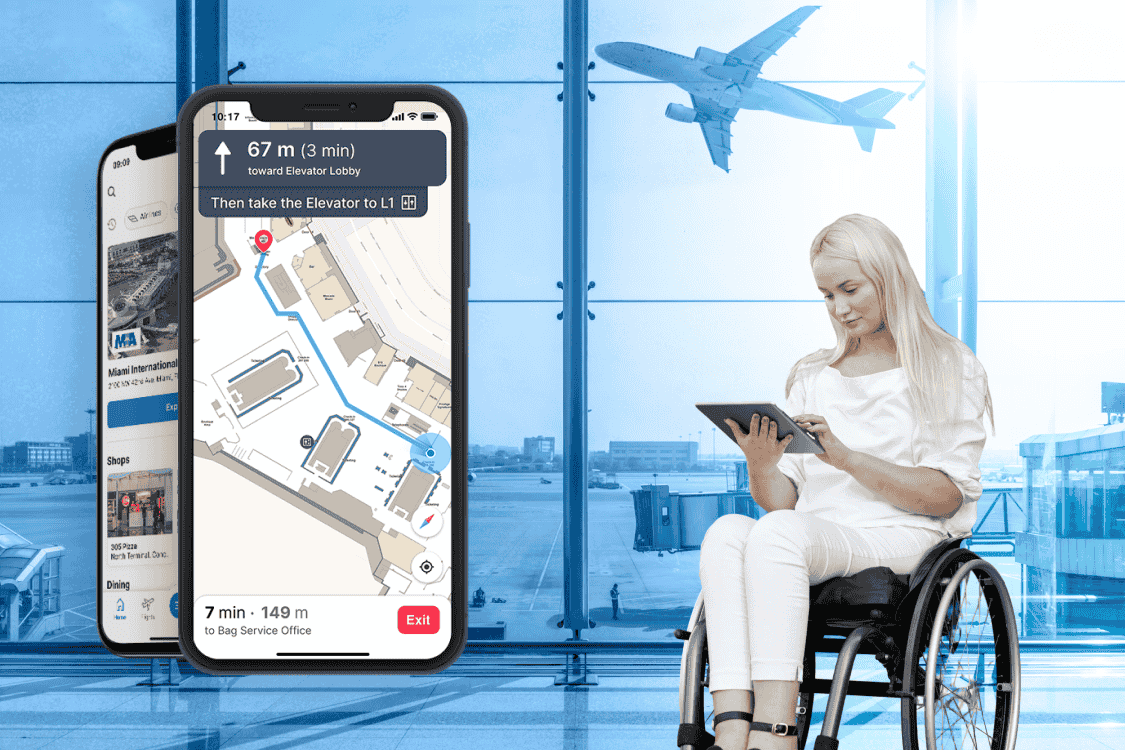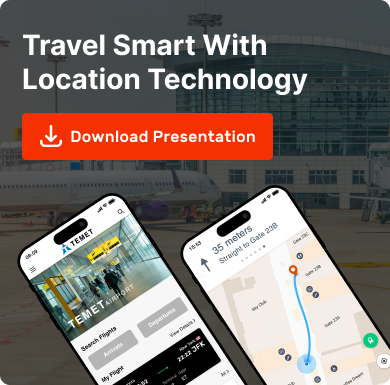Transportation Hubs

Airports are evolving—and accessibility is finally front and center. For travellers with mobility limitations, sensory sensitivities or hidden disabilities, airports can often feel overwhelming. But that’s changing. A growing number of global hubs are investing in Airports for Accessibility and Inclusive Design with smarter layouts, intuitive navigation tools and well-trained staff who understand diverse needs. These ten airports are setting new benchmarks by following the accessibility design checklist for airports, proving what’s possible when user experience meets innovation.
1. Chicago O’Hare International Airport (USA)

- Visual Guidance with Aira App
Chicago O’Hare (ORD) partners with the Aira app to offer blind and low-vision passengers live visual assistance. By connecting to a remote agent via smartphone, travellers receive step-by-step guidance through the terminal.


- Hidden Disabilities Sunflower Program
Staff are trained to recognize sunflower lanyards, ensuring travellers who may need extra patience get it quickly and discreetly.
- Wheelchair-Friendly Layout
O’Hare’s extensive pathways, ramps and elevators make it easier to move around, aligning with the accessibility design checklist for airports.
Why It’s Great:
ORD is one of the best airports in North America for disabled travellers because it focuses on technology and staff training. This shows how Airports for Accessibility and Inclusive Design can use new ideas to make the experience of passengers better.
2. Miami International Airport (USA)

- QR Code Navigation
Miami (MIA) collaborated with Mapsted, a leading location-technology firm to introduce smartphone-based wayfinding. Passengers can scan QR codes to receive real-time directions tailored to wheelchair-accessible routes.
- User-Centric Layout
Terminal corridors and gates are mapped so you can avoid unnecessary stairs and inclines—a hallmark of inclusive airport design.
- Universal Access Upgrades
Wheelchair ramps, priority seating and wide corridors ensure MIA meets top standards for airports with accessible facilities.
Why It’s Great:
Miami’s blend of digital wayfinding and step-free routes cements its position as one of the best airports for disabled travellers. It includes a user-friendly format; MIA proves that wheelchair-friendly airports can improve journeys for everyone.
3. Vancouver International Airport (Canada)

- Self-Driving Mobility Pods
Known as “Cruz” pods, these autonomous vehicles transport travellers with limited mobility anywhere in the terminal, offering independence beyond standard wheelchairs.
- “Travel Rehearsal” Program
YVR allows passengers to practice the airport experience beforehand, reducing stress for first-time flyers, the elderly or those on the autism spectrum.
- Barrier-Free Infrastructure
From wide walkways to tactile floor markings, Vancouver excels at inclusive airport design by considering diverse user needs.
Why It’s Great:
YVR’s innovative approach, especially its driverless pods, places it among the world’s most forward-thinking airports for accessibility and inclusive design. These services underscore the airport’s commitment to continuous improvement.
4. Dubai International Airport (UAE)

- Dedicated Accessibility Lounge
In Terminal 2, Dubai (DXB) introduced a stress-free lounge with wheelchair-accessible seats, contrasting textures for the visually impaired and a quiet sensory area for autism support.
- Sunflower Lanyard Initiative
Staff recognize hidden disability sunflower lanyards, offering extra help if needed.
- Comprehensive Mobility Support
Wheelchair-accessible taxis, free short-term parking for permit holders and certified staff training place DXB high on the list of wheelchair-friendly airports.
Why It’s Great:
DXB’s holistic design ensures travellers with various needs can find comfort and personalized assistance, reflecting how airports with disability services can cater to wide-ranging challenges.
5. Hong Kong International Airport (Hong Kong SAR, China)

- Barrier-Free Accreditation
Hong Kong International Airport (HKIA) achieved ACI Level 3 for Accessibility Enhancement, thanks to thorough planning and user-focused layouts.
- Braille and Tactile Guides
Terminal floors incorporate tactile paths for white-cane navigation, while braille signage and maps offer orientation for visually impaired travellers.
- Fast-Track Channels
Special courtesy lanes shorten wait times during security or immigration, boosting ease for passengers with mobility or cognitive needs.
Why It’s Great:
HKIA’s comprehensive approach—tactile aids, wide counters and staff training—earns it a spot among the best airports for disabled travellers. It’s proof that inclusive airport design depends on both high-tech and practical solutions.
6. Hamad International Airport (Doha, Qatar)

- Accessibility-Focused Concourse E
Newly opened Concourse E includes hearing loops, ramps and extra space between seating areas, following an accessibility design checklist for airports.
- Sensory Room
The Muzn Lounge provides a quiet, calm area for those with autism or other sensory sensitivities.
- ACI-Accredited
Hamad’s accolades reflect its commitment to becoming a prime example of airports with accessible facilities and services.
Why It’s Great:
From state-of-the-art building design to staff who assist with boarding, Hamad ranks among wheelchair-friendly airports that also cater to non-physical challenges, truly embodying inclusive airport design.
7. Indira Gandhi International Airport (Delhi, India)

- Hidden Disabilities Sunflower Initiative
Travellers can wear sunflower-themed gear to discreetly signal their need for extra support.
- Peer-Staffed Assistance Desks
Some help counters are manned by employees with disabilities, creating a welcoming, empathetic environment.
- Free Buggy Service
For covering long distances, the airport provides buggies to elderly or mobility-challenged passengers, reducing fatigue and stress.
Why It’s Great
By weaving empathy into every level of service, Delhi IGI has quickly risen among Asia’s best airports for disabled travellers. Its approach reaffirms how airports for accessibility and inclusive design benefit from active community involvement.
8. Paris Charles de Gaulle Airport (France)

- Universal Communication Tools
Picture boards and sign-language resources help travellers who are nonverbal or have hearing impairments.
- Infrastructure Upgrades
Wider walkways, more ramps and sensory-friendly spaces were installed ahead of the 2024 Olympics and Paralympics.
- Training for Staff
In-depth staff education focuses on spotting hidden disabilities and assisting passengers needing alternative communication methods.
Why It’s Great
By systematically upgrading physical spaces and communication aids, Charles de Gaulle is evolving into one of Europe’s most wheelchair-friendly airports, fulfilling a vision of inclusive airport design where no passenger feels overlooked.
9. Amsterdam Schiphol Airport (Netherlands)

- Autonomous Wheelchairs
Schiphol launched Europe’s first large-scale trial of self-driving electric wheelchairs, boosting independence for travellers with mobility issues.
- Design for All
Tactile floor strips, induction loops and braille signage ensure the terminal is easy to navigate for everyone.
- Accessibility Dashboard
A real-time monitoring system helps the airport track and refine its airports with disability services.
Why It’s Great:
Schiphol’s tech-forward mindset and robust infrastructure make it a trendsetter among wheelchair-friendly airports. It shows how harnessing data can drive ongoing improvements aligned with an Accessibility Design Checklist for Airports.
10. Tokyo Narita International Airport (Japan)

- Autonomous Mobility Vehicles
Narita partnered with WHILL to deploy self-driving electric chairs, assisting not only wheelchair users but also elderly travellers.
- Barrier-Free Guidelines
Wider boarding corridors, tactile paving and accessible restrooms meet Japan’s strict universal design standards.
- Multilingual Support
Kiosks and interfaces offer multiple languages, appealing to Narita’s diverse international passenger base.
Conclusion
These ten airports for accessibility and inclusive design exemplify how universal access can make travel more efficient, stress-free and equitable. Whether it’s a quick hop from the curb to the gate or a high-tech app that guides you through check-in, each airport demonstrates that modern inclusive airport design isn’t just about meeting quotas—it’s about empowering people of all abilities to explore the world with confidence.
As more airports adopt inclusive technology, solutions like Mapsted’s indoor navigation are helping shape the future of accessible travel.
If you found this blog helpful, please read our blog on Top Sustainability Features in Modern Airport Designs Around the World or watch our video on Revolutionizing Airport Navigation: Mapsted at Miami International Airport to learn more.
Frequently Asked Questions
Q1. Why are these airports considered the best airports for disabled travellers?
Ans. They implement advanced accessibility measures—like autonomous wheelchairs, step-free walkways and trained staff—ensuring travellers with various needs can move independently and comfortably.
Q2. What defines a wheelchair-friendly airport?
Ans. A wheelchair-friendly airport typically provides wide corridors, ramps, lifts, accessible restrooms and staff who understand how to offer assistance. Many also use technology such as apps or autonomous vehicles for seamless navigation.
Q3. How does the Accessibility Design Checklist for Airports help?
Ans. This checklist offers a framework for airports to follow when improving accessibility. It covers everything from physical layouts (ramps, signage) to staff training and technology integration—ensuring thorough, consistent upgrades.
Q4. Are hidden disabilities also addressed by these airports?
Ans. Absolutely. Many have adopted programs like the Hidden Disabilities Sunflower, sensory rooms and communication tools (such as sign-language apps) to cater to passengers with non-visible disabilities.
Q5. Which is more important: physical design changes or technology solutions?
Ans. Both are important. Physical design, like ramps and wide hallways, meets immediate mobility needs, while technology, like smartphone apps that help with finding your way and reading, can make independence much greater. Together, they make complete airports with accessible facilities.
Q6: Can I request specific disability services before I arrive at the airport?
A: Yes, most airports with disability services encourage travellers to pre-book assistance. This allows them to better prepare staff, wheelchairs or special equipment so you experience minimal delays.

